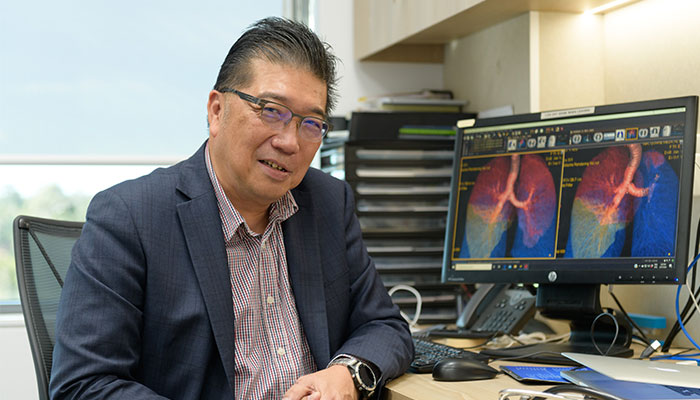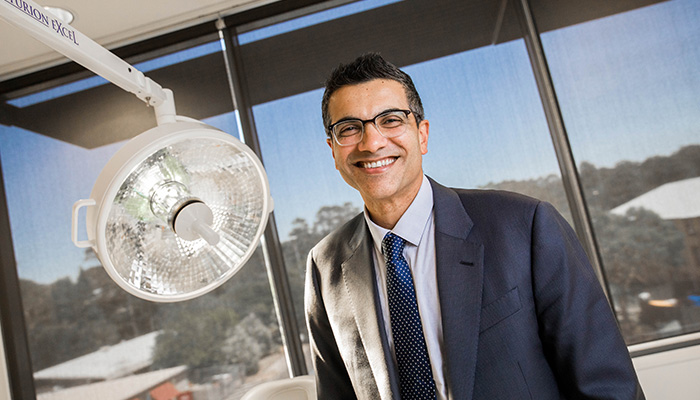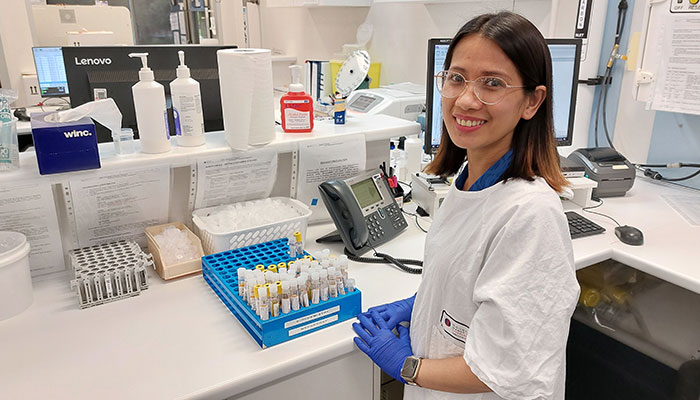After smoking for decades since he was 14 years old, Sydney lawyer Giles (not his real name) had developed chronic obstructive pulmonary disease (COPD). By the age of 67, his quality of life had rapidly deteriorated.

“My condition severely affected my ability to do any physical activities at all,” he says. “Activities such as walking more than 200 metres, doing household chores and carrying out my professional duties as a solicitor and going to court, were all really difficult.”
Professor Alvin Ing, one of Australia’s foremost authorities on lung cancer and respiratory disease at Macquarie University Hospital (MUH), assessed Giles' condition and asked him if he’d agree to be the first patient to try a new procedure.
Together with his colleagues Associate Professor Jonathan Williamson, Dr Tajalli Saghaie and Professor Martin Phillips, Ing proposed an operation using a foam polymer sealant to repair severely damaged parts of Gile’s lungs.
After the repair, Ing would insert one-way valves into the most damaged lobes of the lung, to allow oxygen to be diverted to the less destroyed areas where it would be better absorbed. Without performing the repair procedure first, the use of the therapeutic valves would not be effective.
I can now walk longer distances without stopping and undertake activities that I had struggled with before the procedure.
“In patients with COPD, like Giles, their lungs have been destroyed by cigarette smoke,” Ing says. “It dissolves the lung away, but remarkably, some parts can be well preserved, and by shutting off the bad part of the lung the better parts can take over.”
Surgeons around the world have been tackling this problem for many years. In the 1990s, they performed lung volume reduction surgery and cut away the destroyed parts of the lung.
“However, there was significant mortality and patients died as a result of the procedure,” Ing says. “So we began to research how we could achieve better results without any cutting.”
Polymer glue put to work
A decade ago, Ing became the first physician in Australia to insert endobronchial valves in COPD and emphysema patients. Ing first performed this operation at MUH in 2010, and since then it’s become the leading centre in NSW for this procedure.
But Ing was only able to treat about half the COPD patients he saw this way. For those with fissures or holes between good and bad parts of their lung, these valves would have no effect.

Pioneers: Professor Alvin Ing and Dr Jonathan Williamson co-authored a 'proof of concept' article about the new surgical technique which was published in the Journal of Bronchology & Interventional Pulmonology in January 2020.
“There has to be no communication at all between the good and bad parts of the lung for this procedure to work,” Ing says. “You have to totally close off and collapse the bad part.”
Giles was one of these inoperable patients. So the team tried out a novel technique, using an aerosol polymer glue to repair the holes in the fissures and seal sections of his lung completely. This was the first time globally that physicians had ever performed this operation.
Before the operation I was very confident as I knew I was in good hands with Professor Ing and his team.
In the past, physicians had sprayed the polymer into the bad parts of the lung to reduce its capacity. “But the problem was patients had adverse reactions to it and some even died,” says Ing. With Giles, the surgeons used only a small amount of the polymer - only about 10 - 20 ml as compared to 150 ml – to seal the holes in the fissure. And Giles’ operation was a success.
“Before the operation I was very confident as I knew I was in good hands with Professor Ing and his team,” says Giles. “I was able to stand up a short time after coming out of the recovery ward and only spent one night in the hospital. There was no recovery period as such and I was back at work within a few days.”
- Please explain: why can you see the sun and the moon at the same time?
- Seven positive outcomes of COVID-19
One year since the operation and Ing’s team has just published a “proof of concept” on this procedure and they are in the midst of a clinical trial. “If this is successful we will publish the results in a peer-reviewed journal, and the procedure may be deemed `clinically relevant’. This means physicians and surgeons worldwide may begin to perform this procedure routinely,” Ing says.
Giles’ quality of life has dramatically improved. He now has more than 45 per cent of his lung capacity restored, when he previously had less than 25 per cent before the operation.
“I can now walk longer distances without stopping and undertake activities that I had struggled with before the procedure. I feel much better and I have been able to reduce the frequency of my medication which in turn allows me to give more energy to my business and social activities,” Giles says.

Professor Alvin Ing, pictured, is a Professor in Respiratory Medicine in the Department of Clinical Medicine, Macquarie University.


